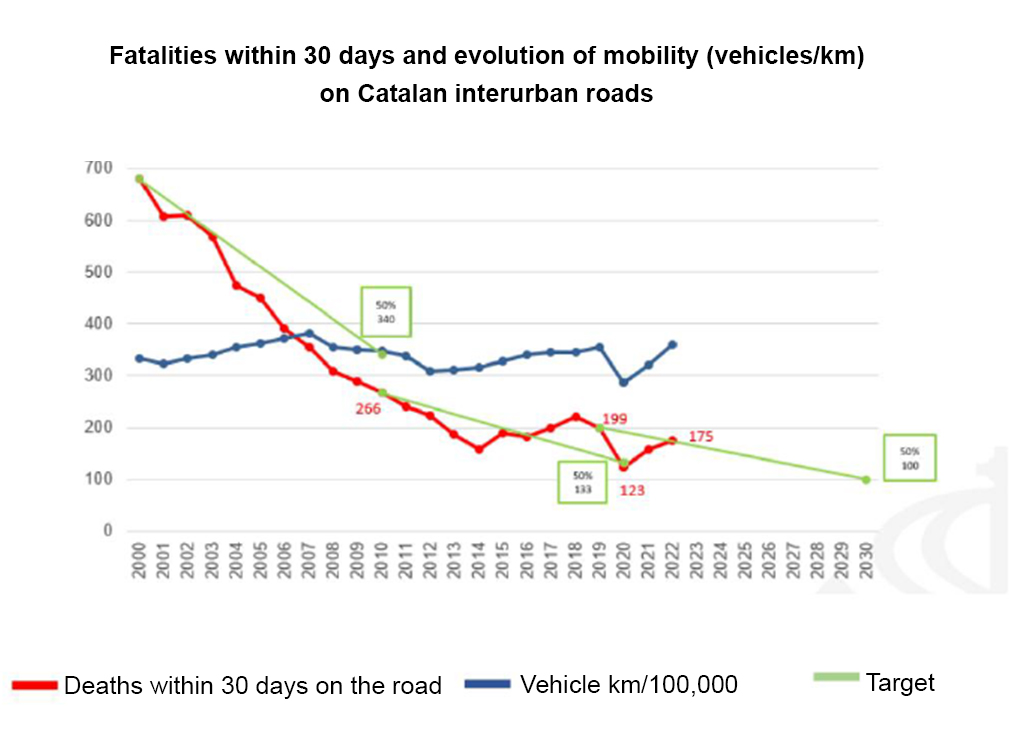Crash Risk Mapping results for the Catalan road network have been released for another year and show motorcycles are involved in 44% of fatal and serious injury crashes despite representing just 2.3% of overall road mobility in the Spanish territory.
Key findings:
- Motorcycles are involved in 30% of total fatal crashes.
- In the three-year period 2020-2022, serious and fatal crashes have decreased by 7%, while global mobility has increased slightly, by 0.4%. These variations mean that the danger has decreased by 7.4% in the overall road network analysed.
- 24% of the road network presents a “high” or “very high” risk of serious or fatal crashes – 1 percentage point less compared to the previous three-year period. By district, Lleida has the highest percentage of kilometres with “high” or “very high” risk (28%) and Girona and Tarragona have the lowest percentages of risk (21%).
- The section with the most serious crashes per kilometre is located on the A-2, between the connection with the AP-2 and the connection with the B-20, B-10 and C-32 (it is the continuation of the Litoral round as it passes through the Baix Llobregat).
- The section with the highest concentration of heavy vehicle crashes is located on the AP-7, between the C-60 interchange and the El Papiol interchange. High crash rates on the road in 2022 particularly contributed to the result, associated with the end of tolls.
- The number of kilometres rated with “very low” and “low” crash risk has grown from 53% to 60%.
In Catalonia, the Reial Automobil Club de Catalunya (RACC), Servei Català de Trànsit, the Department of Territory of the Generalitat of Catalonia and the Provincial Council of Barcelona collaborate to Risk Map the Catalan network each year, and have been publishing results since 2002.
The latest 22nd edition has mapped risk for the period 2020-2022 on more than 6,300km of interurban roads owned by the state, autonomous communities and provincial governments. The analysed network represents where 92% of the territory’s mobility is concentrated and where 74% of fatal and serious injury crashes occur.
The iRAP Risk Mapping methodology is used which compares the number of serious and fatal crashes that have occurred in the last three years with the volume of vehicles on the network (in terms of average daily traffic intensity).
Evolution of fatalities in Catalonia since 2000
The need to improve road safety and reduce crashes is a priority in Catalonia and Europe. Investment in safe infrastructure and the promotion of training and road safety awareness campaigns aimed at drivers of all types of vehicles are essential to improvement.
In Catalonia, the severity of crashes has reduced in the last two decades, from 700 fatalities in the year 2000 to 175 in the last full year recorded.
In each decade, the European Union has had the objective of reducing road casualties by half. The outbreak of COVID-19 contributed to meeting the objective to 2020, seeing a reduction in road crash deaths by 54% compared to 2010. With the passing of the pandemic effect and returned mobility, the number of deaths on Catalan roads is again rising.

A 2023 better than 2022, but with higher motorist mortality
The crash data for 2023 show a reduction in the figures in relation to both 2022 and 2019. As of November 30, 139 people have died in 126 fatal crashes on the interurban road network of Catalonia, which represents a 7% reduction in the number of deaths and a 7.5% reduction in fatal crashes compared to the same period in 2022. If compared to 2019, the reduction is 17% with respect to fatalities and 18% with respect to crashes.
Even so, victims who belong to vulnerable groups – motorcyclists, pedestrians and cyclists – have increased and represent 48% of the total until November 30, 2023 (44% last year). Although five fewer pedestrians (12) and one less cyclist (5) have died compared to the same period last year, motorcyclist fatalities have increased up to 51 deaths (44 in the same period last year), which represent 37% of the fatalities in 2023. This follows from 2020, where COVID-19 impacts contributed to a 40% drop in total motorcycle/moped crashes compared with the previous year.
The latest Risk Mapping results provide detailed data on fatality reductions since 2000, an analysis of risk per region, the 10 road sections with the highest risk of serious or fatal crashes overall and per vehicle type, the road sections of lowest risk, and an analysis of motorcycle and moped crashes since 2012.


















